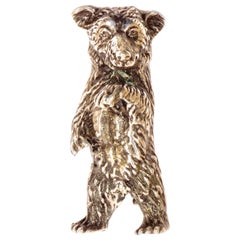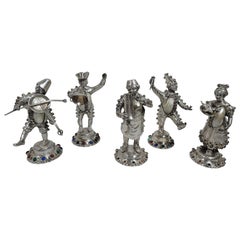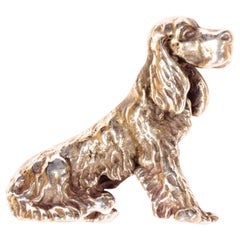Silver Figurines and Sculptures
1980s Vintage Silver Figurines and Sculptures
Silver
1970s Italian Vintage Silver Figurines and Sculptures
Silver
Late 19th Century German Victorian Antique Silver Figurines and Sculptures
Multi-gemstone, Silver
1970s Italian Vintage Silver Figurines and Sculptures
Silver
1940s Italian Vintage Silver Figurines and Sculptures
Vermeil, Sterling Silver
1820s German Early Victorian Antique Silver Figurines and Sculptures
Silver
1890s British Victorian Antique Silver Figurines and Sculptures
Diamond, Pearl, Ruby, Sapphire, Gold, Silver
Early 1900s Austrian Antique Silver Figurines and Sculptures
Silver, Enamel
1850s Italian Renaissance Revival Antique Silver Figurines and Sculptures
Gold, Silver, Steel
2010s American Contemporary Silver Figurines and Sculptures
Diamond, Sapphire, Yellow Sapphire, 18k Gold, Sterling Silver
1970s Italian Vintage Silver Figurines and Sculptures
Silver
2010s Italian Classical Roman Silver Figurines and Sculptures
Sterling Silver
1970s Italian Vintage Silver Figurines and Sculptures
Silver
1970s Italian Vintage Silver Figurines and Sculptures
Silver
Early 20th Century Unknown Edwardian Silver Figurines and Sculptures
Silver
1950s Mexican Artisan Vintage Silver Figurines and Sculptures
Sterling Silver
1980s Italian Early Victorian Vintage Silver Figurines and Sculptures
Silver
1950s Mexican Artisan Vintage Silver Figurines and Sculptures
Sterling Silver
1980s Italian Early Victorian Vintage Silver Figurines and Sculptures
Silver
1980s Italian Early Victorian Vintage Silver Figurines and Sculptures
Silver
1970s Mexican Artisan Vintage Silver Figurines and Sculptures
Sterling Silver
1960s Mexican Artisan Vintage Silver Figurines and Sculptures
Sterling Silver
1980s Italian Early Victorian Vintage Silver Figurines and Sculptures
Silver
1960s Mexican Artisan Vintage Silver Figurines and Sculptures
Jade, Sterling Silver
1980s Artisan Vintage Silver Figurines and Sculptures
Sterling Silver
1980s Mexican Arts and Crafts Vintage Silver Figurines and Sculptures
Sterling Silver
1960s Mexican Artisan Vintage Silver Figurines and Sculptures
Sterling Silver
1980s Mexican Artisan Vintage Silver Figurines and Sculptures
Sterling Silver
1960s Mexican Artisan Vintage Silver Figurines and Sculptures
Sterling Silver
Early 2000s Mexican Artisan Silver Figurines and Sculptures
Sterling Silver
1980s Italian Early Victorian Vintage Silver Figurines and Sculptures
Silver
1980s Italian Early Victorian Vintage Silver Figurines and Sculptures
Silver
1980s Italian Early Victorian Vintage Silver Figurines and Sculptures
Silver
1980s Italian Early Victorian Vintage Silver Figurines and Sculptures
Silver
1980s Italian Early Victorian Vintage Silver Figurines and Sculptures
Silver
1880s Italian Early Victorian Antique Silver Figurines and Sculptures
Silver
1980s Italian Early Victorian Vintage Silver Figurines and Sculptures
Silver
Mid-19th Century British Victorian Antique Silver Figurines and Sculptures
Sterling Silver, Gilt Metal
1980s Italian Early Victorian Vintage Silver Figurines and Sculptures
Silver
21st Century and Contemporary Portuguese Contemporary Silver Figurines and Sculptures
Silver, Sterling Silver
21st Century and Contemporary Portuguese Contemporary Silver Figurines and Sculptures
Silver, Sterling Silver
Mid-20th Century Modern Silver Figurines and Sculptures
Sterling Silver
21st Century and Contemporary Russian Contemporary Silver Figurines and Sculptures
Chalcedony, Black Diamond, Freshwater Pearl, Quartz, Diamond, Sapphire, ...
20th Century French Art Deco Silver Figurines and Sculptures
Agate, Diamond, Emerald, Rock Crystal, Gold, Silver
2010s Russian Contemporary Silver Figurines and Sculptures
Citrine, Garnet, Cultured Pearl, Sapphire, Gold Plate, Silver
20th Century French Silver Figurines and Sculptures
Quartz, Turquoise, Ruby, Rock Crystal, Jade, Diamond, Amethyst, Silver, ...
21st Century and Contemporary French Silver Figurines and Sculptures
Diamond, Lapis Lazuli, Rock Crystal, Gold, Silver
21st Century and Contemporary Russian Contemporary Silver Figurines and Sculptures
Gold Plate, Silver
21st Century and Contemporary Portuguese Contemporary Silver Figurines and Sculptures
Silver, Sterling Silver
21st Century and Contemporary Russian Contemporary Silver Figurines and Sculptures
Amber, Carnelian, Multi-gemstone, Silver
21st Century and Contemporary Russian Contemporary Silver Figurines and Sculptures
Gold Plate, Silver




